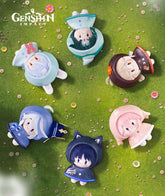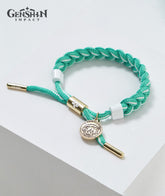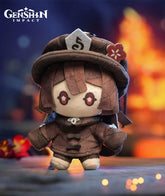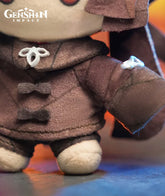Seal, Kachina & Pika? Analyzing Natlan Gosanke Characters
The 5.0 Character Preview was released on time. In addition to this more detailed introduction, we've learned more about some of the characters and information on the Natlan area, so it's worth doing a summary and koan here.

Splish-Splash Wavechaser: Mualani

Meztli, or the People of the Springs, is a tribe in Natlan. It is currently unknown when this tribe was founded. The Meztli have a long history of serving as guides and cartographers.
In terms of how well they know Natlan, perhaps even the birds that gaze down upon this land from high up above would fall short of the guides from the People of the Springs. Long, long ago, their forerunners once measured the world with their feet, transforming the winding, perilous paths they walked into networks of orderly lines on their maps.
As a member of the People of the Springs' new generation of young guides, Mualani has already established an eminent name for herself throughout Natlan. With her to lead the way, you'd be sure to experience the spectacular sight of volcanic eruptions, breathe in the refreshing natural fragrance of Embercore Flowers, even witness spontaneous performances put on by packs of Koholasaurs. But likewise, if there was an emergency or you just needed to be somewhere urgently, she'd find a shortcut to get you there as safely, soundly, and smoothly as possible.
They live alongside the Koholasaurus and like to bathe in the Hotsprings with them. The dragon's name is a compound combination of Kohola + Saur. Kohola is taken from the Hawaiian term Koholā, which means "Humpback Whale."

Natlan Saurian: Koholasaur
Mualani's name is also derived from Hawaiian culture.
Mualani (also called Muolani or simply Mua; lani = "heaven/sky" in Hawaiian) was a Hawaiian High Chiefess who lived on the island of Oahu and was a Princess of Koʻolau.
Princess Mualani was of Tahitian ancestry as a descendant of the wizard Maweke who came to Oahu from Tahiti.
Phoca Neomonachus is Mualani's Constellation.This name relates to the Neomonachus genus, which includes the Hawaiian monk seal (Neomonachus schauinslandi), the Hawaiian Islands' sole endemic mammal other than the Hawaiian gray bat. This beautiful species is now endangered because of overhunting and habitat loss, with only approximately 1,100 left.

Turnfire Hunt: Kinich

The character introduction reveals that his career is that of the cool-sounding "Saurian Hunter," but against the backdrop of Natlan, where humans and Saurians live together in harmony, he was destined for this job from the start to be ignored and misunderstood by others.
In a land full of heroes, their practice of assessing commissions and setting a price makes the profession even more controversial.
A cruel, ruthless, cold-blooded killer... Pragmatic, utilitarian, without so much as a hint of chivalrous decorum... In such heartless, damning terms do people describe the young man that never argues back. Because he understood the importance and actual significance of the mission he inherited as a Saurian Hunter.
As long as the price is right, all commissions shall be fulfilled in a satisfactory manner; all writhing, raging aberrants returned to the Night Kingdom from whence they came.
Once the bearer of the Turnfire name has locked onto a target, there's no looking back.
Kinich belongs Huitztlan. Like the other known tribes, Huitztlan is likely derived from Ilhuicatl-Huitztlan, one of the Aztec Thirteen Heavens. It specifically refers to the fourth level, Ilhuicatl-Huitztlan, also known as the The sky of the Big Star, which is home to Tlahuizcalpantecuhtli god of dawn and the morning star Citlalpol or Hueycitlalin (Venus).
Kinich Ahau (Mayan: [kʼiː.nitʃ a'haw]) is the 16th-century Yucatec name of the Maya sun god, designated as God G when referring to the codices. In the Classic period, God G is depicted as a middle-aged man with an aquiline nose, large square eyes, cross-eyed, and a filed incisor in the upper row of teeth. Usually, there is a k'in ('sun')-infix, sometimes in the very eyes, appears to have been in general use as a royal title during the Classic Period.

Ah Kʼin is Yucatec for 'someone who deals with the day(s)', the word for 'day' and 'sun' being the same. The term refers to Yucatec calendar priests and to priests in general. This aspect highlights the calendar's unusual prominence in Mayan sun worship since the person in command of the calendar was seen by the Mayans to be in charge of examining humanity's future.
Chimaera Alebriius is Kinich's Constellation, with the first half taken from the Latin term Chimaera, which relates to the monster "Chimera" from Greek mythology and is currently used to refer to fictional creatures with parts taken from various animals.

The second half, Alebriius, may be inspired by "Alebrijes," are brightly colored Mexican folk art sculptures of fantastical (fantasy/mythical) creatures, created by the Mexican artist Pedro Linares in 1936, and which is now the subject of the annual Desfile de Alebrijes en Ciudad de México (Parade of the Alebrijes), where artists and citizens express their imaginations.

Like Kinich, the archetype of the name K'uhul Ajaw is linked to Mayan culture. Ajaw is a Mayan political title that means "Lord," whereas K'uhul means "Godlike" or "Sacred" in Mayan, and represents a god or sacred thing. As a result, the name K'uhul Acho means "divine lord".

Mottled Gold Yet Unsmelted: Kachina

Kachina is described as a kind, bold, and strong-hearted youngster, as a young warrior, who attained the esteemed title of "Uthabiti" in her tribe at an early age.
Not long after we first met, I saw Kachina crying, and tried to hand her a handkerchief. But smiling back, she said to me, 'Don't worry, I'll wipe my own tears away.' That was a moment I'll always remember. So don't you worry about her either — the girl's made of strong stuff. Just make sure you give her all the encouragement she needs.
—MualaniGrowing up in such an environment, the occasional bump or scratch was unavoidable, and when she hurt herself, Kachina would cry out in pain just like any other child. But long before others had recovered from their pain, she would have wiped away her tears and stood back up again.
The name "Uthabiti" is derived from the African word Kiswahili (of the Bantu language group, one of the most widely spoken languages on the continent and one of the three major languages of Africa, along with Arabic and Hausa), which means "resilience" and corresponds to Kachina's strong qualities.
Kachina belongs to Nanatzcayan. Like the other known tribes, Nanatzcayan is likely derived from Ilhuicatl-Nanatzcayan, the eighth level of the Thirteen Heavens in Aztec mythology, where the obsidian knives are creaking. Mictlantecuhtli, god of death and ruler of Mictlan (the Underworld), and his wife, Mictecacihuatl, live in Ilhuicatl-Nanatzcayan. This is also why the Natskayan clan is known as the "Children of Echoes".
the Nanatzcayan people are fine miners and excavators and skilled appraisers of gems who live in the mines in eastern Natlan. The Tepetlisaurs help them by mining and finding the best ores .The name consists of the compound Tepetl + Sauri, with the prefix Tepetl- a modern dialect of Nahuatl (Nāhuatl; historically the official language of the Aztec empire, and still spoken by more than a million people in Mexico today) meaning "mountain, precipice", corresponding to "crest"; and the suffix - Sauri has been discussed above.

Kachina is derived from Kachina, a spirit in the Puebloan religion.(The Puebloans, or Pueblo peoples, are Native Americans in the Southwestern United States)
Katsina are real-world spirits or objects that reflect everything from Pueblo ancestors to human spiritual traits, a region, a range of natural species, or fantastical conceptions. This idea is based on the realization that "everything has a spirit."The Pueblo people believe that Katsina spirits pay visits to their tribes on occasion and that if these strong entities are revered and honored, they can utilize their particular abilities to aid humanity by providing rain, healing, fertility, or protection.
For this reason, many Pueblo tribes hold Kachina ceremonies in which Kachina Dancers perform in costume and small wooden dolls carved in the image of the Kachina, known as Kachina Dolls, are given to those responsible for the children's care (such as mothers, wives, or sisters) as a sign of blessing. The Kachina ritual is a significant cultural heritage for the Pueblo people, and the diverse collection of Kachina dolls is an excellent depiction of their art.

Various Kachina dolls
Ochotona Princeps is Kachina's Constellation. The American pika (Ochotona princeps), a diurnal species of pika, is found in the mountains of western North America, usually in boulder fields at or above the tree line. It's easy to see how Kachina's look is a reference to this critter.












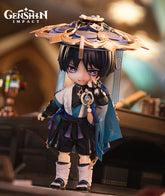


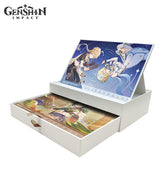





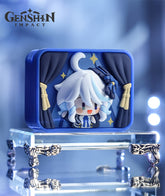
![[Official Merchandise] Genshin Impact Theme Vision Keychain Charm](http://genshinfans.com/cdn/shop/files/ZT01_4ff643a3-f4c7-4e69-949d-97312b5da85d_165x.jpg?v=1722241611)
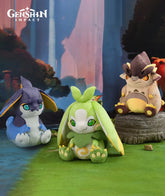
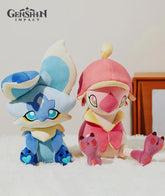
![[Official Merchandise] Wanderer Scaramouche Cat Hanging Plush Toys](http://genshinfans.com/cdn/shop/files/zt-05_165x.jpg?v=1698818423)
![[Official Merchandise] Wanderer Scaramouche Cat Hanging Plush Toys](http://genshinfans.com/cdn/shop/files/zt-06_165x.jpg?v=1698818424)
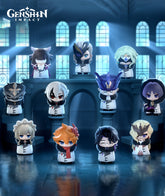



![[Official Merchandise] Genshin Impact Slime Plush Toys](http://genshinfans.com/cdn/shop/products/ZT06_165x.jpg?v=1691978287)
![[Official Merchandise] Genshin Impact Slime Plush Toys](http://genshinfans.com/cdn/shop/files/ZT02_6137d7a6-4ee1-4a82-9495-4a12b1032ea2_165x.jpg?v=1691977956)


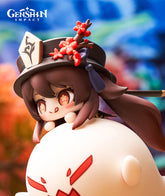
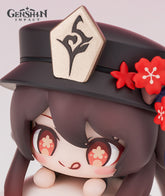
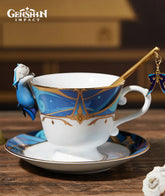

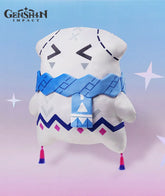

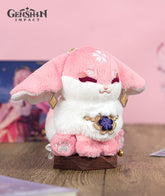
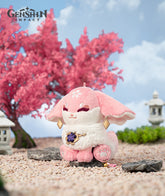
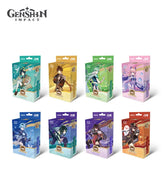

![[Official Merchandise] Arlecchino Impression Afternoon Tea Cup and Saucer Set](http://genshinfans.com/cdn/shop/files/Arlecchino-Impression-Afternoon-Tea-Cup_165x.jpg?v=1714383254)
![[Official Merchandise] Arlecchino Impression Afternoon Tea Cup and Saucer Set](http://genshinfans.com/cdn/shop/files/Arlecchino-Impression-Afternoon-Tea-Cup2_165x.jpg?v=1714383255)
![[Official Merchandise] Kaedehara Kazuha Impression Bracelet](http://genshinfans.com/cdn/shop/files/ZT02_cacb626a-33db-414d-aab1-63e59b0a0ba8_165x.jpg?v=1698747523)
![[Official Merchandise] Kaedehara Kazuha Impression Bracelet](http://genshinfans.com/cdn/shop/files/ZT04_79fecbdd-ac05-4a1a-9488-4814e86eeee1_165x.jpg?v=1698747523)
